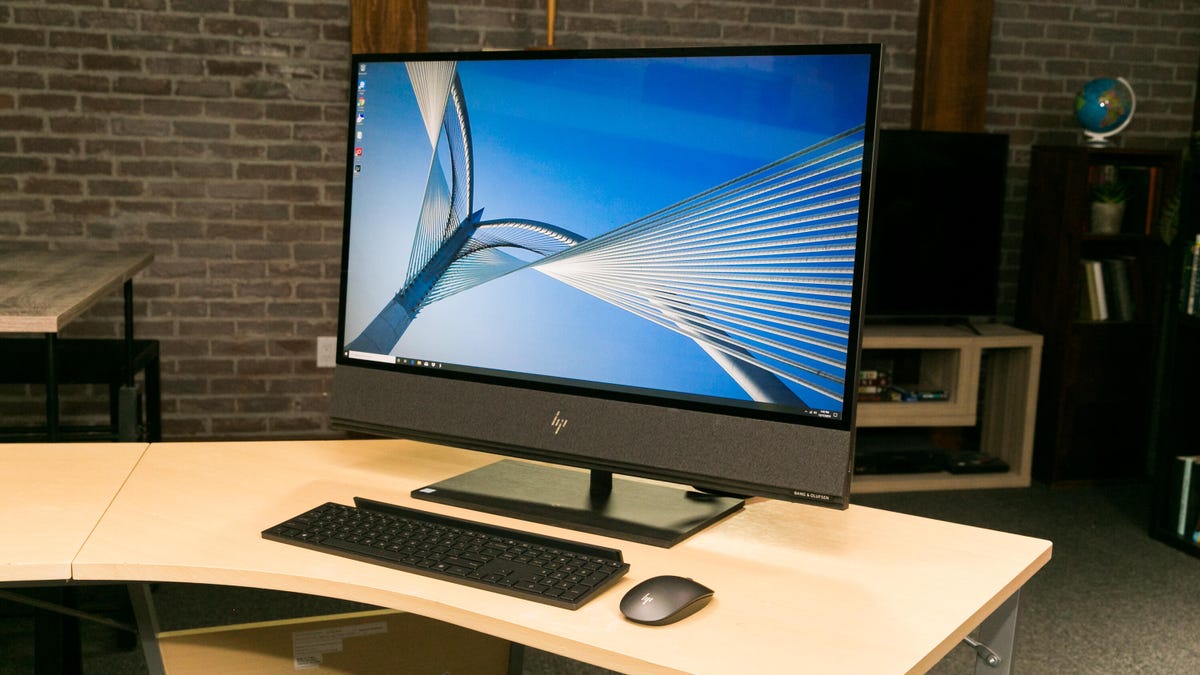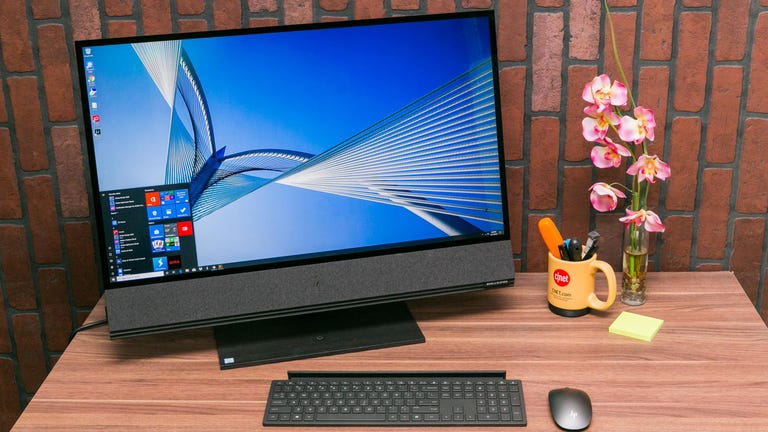 Why You Can Trust CNET
Why You Can Trust CNET HP Envy 32 AIO review: Big, bright and booming
Launched at CES 2020, a great 32-inch DisplayHDR 600 screen and a powerful sound system are only the beginning for HP's latest all-in-one.

I've never been a big fan of all-in-ones, though I can't put my finger on why. Possibly because they've always felt overgrown laptops and full of compromises. HP's Envy 32 AIO, launched at CES 2020, still feels a bit smaller on the inside like most of its ilk, but it's packed with enough features and a classic smart design that shouldn't feel old in a couple of years to its intended audience: folks who need more-than-average power for photo or video editing or a speaker system decent enough for basic audio editing and entertainment, as well as those who just want a compact computer with all its space devoted to a big, bright 4K screen.
Like
- Big, bright 4K screen
- Respectable 1080p gaming and graphics performance for an all-in-one
- Very good speaker system and audio features
- Premium bundled keyboard
- Sensible, low-key design
Don't like
- You can't adjust the height of the display
- Seems slow to boot
HP is quick to boast about some of its all-in-one-specific firsts -- the first DisplayHDR 600 screen and first with Nvidia GeForce RTX graphics -- as well as to make some oddball "best" claims, like the it's world's loudest AIO and the world's widest 4K screen in an AIO.
There are AIO's with wider screens, like HP's own Envy 34 Curved, but they're all lower-resolution (such as 3,440x1,440 instead of 3,840x2,160) and 21:9 aspect ratios rather than the more common 16:9. The ultrawide displays can be an issue for graphics work, as well, since the curve can mess with your perception of straight lines and negatively affect color accuracy/uniformity. I suppose "loudest" is a big plus if you live in an apartment and hate your neighbors.
HP Envy 32 All-in-One
| HP Envy 32 All-in-one | |
| Price as reviewed | $2,499.99 |
| Display | 31.5-inch 4K UHD DisplayHDR 600 |
| CPU | 3.0GHz Intel Core i7-9700 |
| Memory | 32GB 2,667MHz DDR4 SDRAM |
| Graphics | 6GB Nvidia GeForce RTX 2060 Max-Q |
| Storage | 1TB SSD+32GB Intel Optane, SD card slot |
| Ports | 2 x USB-C (1 x Thunderbolt 3), 3 x USB-A 3.1, 2 x HDMI 2.0 (1 out, 1 in), 1 x combo audio |
| Networking | Gigabit Ethernet, Wi-Fi 5 (802.11ac) 2x2, Bluetooth 5.0 |
| Operating system | Microsoft Windows 10 Home (1909) |
The touted 8GB GeForce RTX 2060 graphics processor is an option for the highest-end $2,500 configuration; the $1,800 base configuration comes with a 4GB GTX 1650 as well as a six-core Intel Core i5-9400, 16GB RAM and a 256GB SSD plus 1TB HDD. Other upgrades from the base configuration include 32GB RAM, a 1TB SSD (or 1TB SSD plus 32GB Intel Optane fast cache).
The base price is the same as the 27-inch iMac. The iMac only has 8GB RAM and a 1TB Fusion drive, but MacOS performs much better with 8GB memory and without SSD than Windows. It's as you configure the options that the prices start to diverge, in part because the iMac choices jump straight from an i5 to an i9 with no stops at i7 along the way.
One thing to keep in mind when looking at the Envy's specs is that the RTX 2060 is the low-power, low-noise Max-Q version used in laptops, which also means the system automatically decides whether to use the integrated graphics or the discrete. That's really annoys some people. The CPUs are higher-power desktop processors (65 watt) and perform better than the typical 45-watt mobile CPUs used in Windows all-in-ones, despite the lack of hyperthreading support (e.g., the i7 is 8 core/8 thread, not 8 core/16 thread).
Highlights
Standout aspects of the Envy 32 AIO include
- A great screen. As tested (using Portrait Displays' Calman 5 Ultimate and an X-Rite i1Display Pro Plus) in Native mode (not the default), it covers 98% of the D65 P3 gamut and quite accurate in that space -- Delta E < 2 as advertised, with 2.2 gamma, contrast typically a minimum of about 1,240:1 and a peak brightness in SDR of around 400 nits (default is about 260 nits) and typically 650 nits in HDR. Adobe RGB is less accurate, though still good for a consumer display. It's one of the least reflective non-matte screens I've used, as well. An HDMI input lets you use it as a standalone monitor, and unlike most AIOs it has an onscreen display like a regular monitor with all the usual options; there's also a utility to do it in software. And 32 inches feels noticeably bigger than 27. My one complaint is that the contrast is bumped up, which makes text look overprocessed. Most people don't notice things like that, though.
- Great sound for built-in speakers, with some nice perks. The Envy has a six-speaker, front-firing 2.1 system under the screen, with two tweeters, two medium drivers, two passive radiators and a woofer in the center. It's not as sophisticated as the 10-speaker system that was in the Dell XPS 27, but you can't get that anymore. So yes, this is probably the loudest and best-sounding all-in-one, delivering clear highs and lows and blasting at top volume with little distortion. It also supports a new version of HP's Advanced Audio Stream, which lets you connect a phone or other device via Bluetooth and sling audio to the speakers. In this model there's also a separate Bluetooth chip for the speakers, so you still can play via the speakers while the system is off.
- Better than average bundled keyboard. The wireless keyboard feels like it has a little more travel and responsiveness than the typical kit keyboard. You can also assign Bluetooth pairings to two dedicated buttons, in addition to the desktop connection. That's not an unusual capability, but it is for a bundled keyboard. Plus, it has a ledge that can hold a phone and tablet, which are the intended devices to use it with. The keyboard's not backlit, though, which is a disappointment.
- An attractive, functional design. Like the older Envy all-in-ones, the 32's aesthetic is a little faux-woodier than the typical ultramodern competitor. Unlike its predecessors, the guts of the system are in the monitor section rather than the base. I prefer the latter, since it's generally easier to reach the connectors when they're on the base, but the move was necessary in order to accommodate the speaker system. HP compensates by putting one USB-A connection on the right and an SD card slot plus headphone jack on the left. There's only one USB-C/Thunderbolt 3 connection, but that's more than a lot of
desktops
. And finally, the base has a wireless charging pad. Unfortunately, you can't raise or lower the display, which means if you're especially tall or especially short, it may not be very comfortable.
- Solid performance. As a system, it doesn't especially stand out for its performance, even the RTX-equipped model we tested. Gaming was right in line with laptops using the RTX 2060 Max-Q, for satisfactory 1080p play (though that's a bit of a waste of the 4K screen). And it handled photo editing in Adobe Lightroom Classic without issue.
Geekbench 4 (multicore)
Cinebench R15 CPU (multicore)
3DMark Fire Strike Ultra
System configurations
| Apple iMac 27 (2019) | Apple MacOS Mojave 10.14; 3.7GHz Intel Core i9-9900K; 16GB 2,666MHz DDR4 SDRAM; 8GB Radeon Pro Vega 48; 512GB Apple SSD APFS |
|---|---|
| HP Envy 32 All-in-One | Microsoft Windows 10 Home (1909); 3.0GHz Intel Core i7-9700; 32GB 2,667MHz DDR4 SDRAM; 6GB Nvidia GeForce RTX 2060 Max-Q; 1TB SSD |
| Lenovo Yoga A940 | Microsoft Windows 10 Home; 3.2GHz Intel Core i7-8700; 16GB 2,667MHz DDR4 SDRAM; 4GB Radeon RX 560X; 256GB SSD + 1TB HDD |
| MIcrosoft Surface Studio 2 | Microsoft Windows 10 Pro; 2.9GHz Intel Core i7-7820HQ, 32GB DDR4 SDRAM 2,400MHz, 8GB Nvidia GeForce GTX 1070; 2TB SSD |


